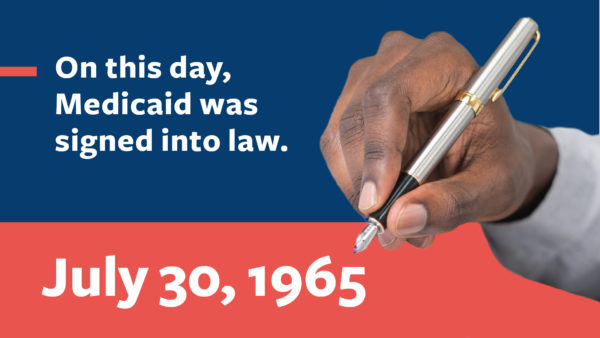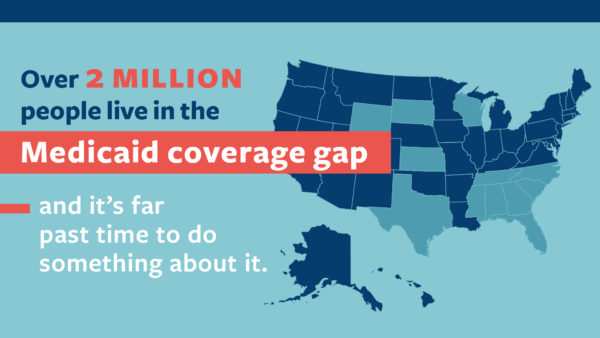
Today, on the 56th anniversary of Medicare and Medicaid, we have a tremendous opportunity to make strides toward achieving universal coverage and affordable access to health care as a nation. By passing a bold budget package that makes much-needed changes to Medicare and closes the Medicaid coverage gap, Congress can help improve the health and well-being of millions of Americans and put us on a path toward an equitable recovery. On the anniversary of Medicare and Medicaid, let’s look back at how we got here – and how far we still have to go.
What are Medicare and Medicaid?
President Lyndon B. Johnson signed Medicare and Medicaid into law on July 30th, 1965, as part of a number of measures aimed at eradicating poverty and improving living standards in the U.S.
Medicare is a federal insurance program for U.S. citizens and permanent legal residents 65 or older and for adults with disabilities. Medicare consists of four major components that provide varying levels of coverage. Most enrollees receive coverage for inpatient and hospital care and some outpatient services at no or low cost. Consumers can opt to pay more for additional benefits, such as vision, dental, and drug coverage. Medicare has significantly reduced costs and improved outcomes for elderly and disabled U.S. citizens and currently covers over 60 million recipients. By insuring the most costly-to-cover populations, Medicare improves the entire market by driving down costs for everyone.
Medicaid, also known as Apple Health in Washington State, is a state-administered health insurance program that provides coverage to low-income enrollees at no or minimal cost. Federal restrictions bar immigrants from receiving Medicaid benefits, with some temporary exceptions during pregnancy or medical emergencies.
Since the creation of Medicare and Medicaid in 1965, expansions like the ACA have significantly improved health access, coverage, and outcomes. After the passage of the ACA in 2010, 20 million Americans gained insurance coverage. The largest increase in coverage was in 2014 when the provisions of the law expanding Medicaid and opening the health insurance marketplaces went into full effect. As of February 2021, nearly two million Washingtonians were enrolled in Apple Health and 73,661 children were enrolled in Apple Health for Kids. Studies have also indicated that Medicaid, Medicare, and premium subsidies on the exchange are among the most important anti-poverty programs in the country, accounting for over one-third of the poverty reduction for all public benefits for people in households without a disability recipient. Medicaid alone has a larger impact on child poverty than all non-health benefits combined.
Thanks to the Affordable Care Act (ACA), some states, including Washington, expanded Medicaid to cover adults with incomes below 133% of the Federal Poverty Level (FPL), which translates to an annual income of about $18,000 for a single adult and about $35,000 for a family of four in 2021. Apple Health for Kids, the Medicaid program for children up to the age of 19 in Washington State, covers all low- -income children regardless of citizenship status.
In particular, Medicaid and ACA-related expansions have been critical to helping people access health coverage during the pandemic. As people faced job losses early in the pandemic, they also faced the loss of their employment-based health insurance and uninsurance rates initially shot up to as high as one in five working-age adults. Medicaid and state marketplace programs provided critical safety nets for the unemployed and underemployed, helped people access essential COVID-19 related and unrelated care, and prevented the massive and prolonged uninsurance levels that were common during the Great Recession.
Who is still left out – and why is it urgent to act now?
As we honor these historic programs, we must also continue to improve access to affordable coverage, particularly for the millions of people who still lack comprehensive and affordable health care.
Over two million low-income people still lack access to affordable health coverage in the 12 states which have failed to expand Medicaid. Closing this Medicaid coverage gap is an urgent racial and economic justice issue: because of systemic racism and prevailing barriers to financial security, sixty percent of low-income people who lack access to Medicaid coverage are people of color.
Congress is considering solutions to closing the Medicaid coverage gap. One such solution, the Medicaid Saves Lives Act, has been proposed by Senators Warnock, Ossoff, and Baldwin (and Representative Bourdeaux in the House), and would create a Medicaid-style federal program for people with incomes at or below 138% FPL in the 12 states where state leaders continue to deny Medicaid expansion.
While Medicare offers critical coverage to more than 60 million elderly and disabled Americans, crucial benefits like vision, hearing, and dental are not included, which can lead to people forgoing important and routine medical care and equipment such as eyeglasses, hearing aids, and regular dental exams.
As Congress negotiates a $3.5 trillion budget package, it is vital to improve Medicare coverage and close the Medicaid coverage gap. A strong package will include key priorities, such as:
- Closing the Medicaid “Coverage Gap” in the States that refused to expand,
- Adding dental, vision, and hearing benefits to Medicare,
- Expanding Home and Community-Based Services to help enable caregiving for elderly and disabled people,
- Making American Rescue Plan Act premium subsidies permanent,
- Allowing the federal government to negotiate prescription drug prices on behalf of Medicare beneficiaries.
We as a country have the opportunity to ensure a common-sense approach to health care, address racial disparities, and recover from the COVID-19 pandemic and recession. Congress must act now to deliver a recovery package that meets the moment by including key measures to close the coverage gap, expand services, and improve care for all.
More To Read
September 10, 2024
Big Corporations Merge. Patients Pay The Bill
An old story with predictable results.
July 31, 2024
New poll in Washington finds people struggling with health care costs at an alarming rate
More than half (57%) of respondents have avoided seeking medical treatment or modified their use of prescriptions in the last year due to the cost
July 15, 2024
It’s too expensive to get sick – it’s time to protect Washington patients
The extraordinary cost of medical debt.
